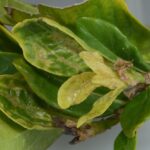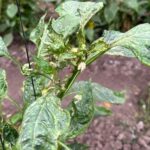Nursery growers and landscapers should stay vigilant for an invasive thrips that is moving across the USA. Thrips parvispinus was first detected in Florida in 2020. It has since spread through Georgia and the Carolinas, and has been detected in Colorado, Ohio, Pennsylvania, and Delaware. It is not known to occur in Indiana, but growers who receive nursery stock from these states should be aware of this invasive insect.
Thrips parvispinus has been reported on dozens of host plants, including numerous ornamentals, vegetables, fruits, and legumes. Their feeding injury causes stippling and bronzing on leaves, and they also distort the developing buds and cause severe deformation of leaves and fruits.
- Figure 1. T. parvispinus damage to gardenia terminal. Image credit: Lyle Buss, University of Florida. Source article.
- Figure 2. Chili peppers infested with T. parvispinus. Source publication: Payán-Arzapalo, María et al. 2025. Florida Entomologist, 108:1.
Figure 1. Source article. Figure 2. Source article
Prevention and early detection are crucial to stop this insect from spreading. Sticky cards are great for passive sampling, or you can scout by tapping plants over a white sheet of paper to dislodge thrips and other pests. Thrips parvispinus are extremely small – only 1 mm long – so make sure you have a hand lens. The adult females have a brown/yellow head and thorax, and a dark black abdomen. The males are lighter in color and only have black coloration on the dorsal side of the abdomen.
If you are concerned that you found this species, you can reach out to the Invasive Species Hotline at 866-NO-EXOTIC [866-663-9684], or send suspect samples to the Purdue Plant & Pest Diagnostic Lab for diagnosis.

